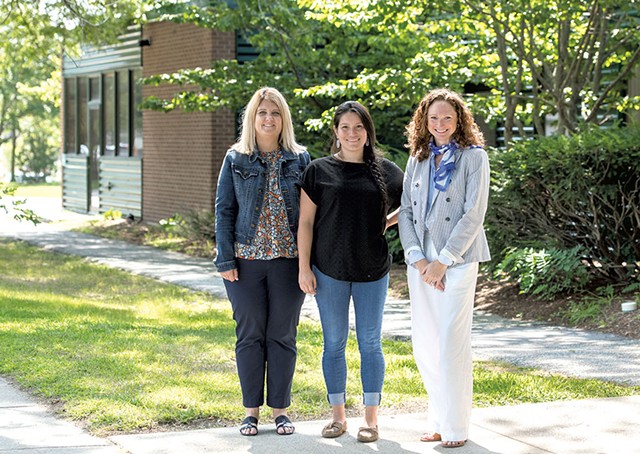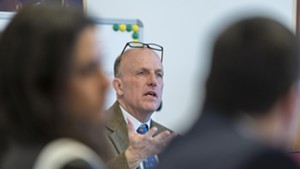
- Daria Bishop
- From left: Kristin Romick, Katie Cunningham and Violet Nichols of the South Burlington School District
Facing a shortage of spots in schools that serve students with special needs, two Chittenden County public school districts have launched their own in-house programs this year. Administrators say this approach will cost the same as — or less than — the districts currently spend and will provide other benefits for students who will be able to learn closer to home.
The Essex Westford School District has created the ARC Center — which stands for Academics, Relationships and Community — for students in grades three through eight who qualify for special education and require a high level of care. The South Burlington School District, meanwhile, has started a yet-to-be-named program that will provide one-on-one and small group instruction and counseling to about 10 middle and high school students.
Leaders in both districts said they had no choice but to start homegrown programs to ensure that special education students receive the services they are entitled to by law.
"Developing this program happens to be fiscally responsible and meets legal requirements," South Burlington superintendent Violet Nichols wrote in an email to Seven Days. "But it's also critical for supporting our values of equity, access and inclusion."
Vermont's therapeutic schools operate independently but are paid by public school districts to educate students who need intensive academic, emotional or behavioral care. Administrators across the state say openings in therapeutic programs have become increasingly scarce in recent years, while students' needs have become more complex.
Moreover, in June, the state legislature put a moratorium on all new independent schools in an effort to curtail the flow of public dollars into private programs.
Existing placements are disappearing, as well. This summer, two Chittenden County therapeutic schools — Mosaic Learning Center and Centerpoint School — shut down, eliminating several dozen seats. The closures left just five therapeutic schools in the county, many of which are small or serve only specific groups, such as students with autism.
When South Burlington learned of Centerpoint's closure in late June, "we knew that we needed to develop a therapeutic alternative program to support our students," superintendent Nichols said.
South Burlington's new program will be familiar to the five students from the district who attended Centerpoint. The district is renting the school's former counseling building on Airport Drive and has hired four of its former employees, including education director Katie Cunningham and clinical director John Grimm.
Getting a program up and running in eight weeks has been a heavy lift, according to Kristin Romick, the district's special education director. But she said she's looking forward to building on Centerpoint's work.
Cunningham, who will serve as the new program's director, said parents she's talked to appreciate that their children will learn in a familiar place this year, with teachers they already know. Building relationships with students is key to therapeutic programs' success, she noted.
The program will serve South Burlington's five students and five from other Chittenden County districts.
"Opening up spaces for neighboring schools was important to us," superintendent Nichols said.
In Essex Westford, the district has had difficulty finding staff for the new program, so it will begin with limited capacity, according to Erin Maguire, the district's codirector of student support services. The district hopes eventually to serve 20 students with about 11 staff members, including classroom teachers, social workers, a curriculum specialist who can tailor lessons for each student, and behavior interventionists — staff who work with children to strengthen their social and behavioral skills.
The program will use a building between the district's grades 3-5 school and middle school. That location will allow ARC students to attend classes such as music and physical education at the neighboring schools when appropriate. That flexibility isn't possible when students are sent out of the district.
Essex Westford had been considering starting its own therapeutic program since 2017, according to Maguire. But it was the closures of Mosaic and Centerpoint, plus the moratorium on new independent schools, that prompted the district to act, she said.
The concept of therapeutic programs run by public schools is not a new one.
Until the late 1980s, the state had a number of publicly run regional programs for students with disabilities. They were eliminated as Vermont moved toward a model of educating as many students as possible in mainstream classrooms. The general-education setting didn't work well for every student, though, and independent therapeutic schools cropped up to fill the need.
In the mid-1990s, now-retired special education administrator Jo-Anne Unruh helped to establish the Wilder School. It's run by the Hartford School District and includes separate programs for children with autism and for those with behavioral issues. Students attend from nine supervisory unions in Vermont and New Hampshire.
For more than 10 years, the Windham Central Supervisory Union in southern Vermont has offered its HOME Program — Hands On Minds Engaged — for middle and high school students. Eight to 12 students spend time with general-education peers but also do their own community service work, take camping trips and complete hands-on projects such as boatbuilding.
Expanding on that success, Windham Central created another therapeutic program two years ago for K-5 students at one of its elementary schools.
Stephanie Betit-Hancock, the district's director of student services, said the new program's in-school location gives its students more chances to mingle with kids from other elementary classrooms. They can eat lunch with their general-ed peers, for example, and can participate in afterschool activities and sports.
"I think we in Vermont ... feel very strongly that students should be educated as close to home as possible," Betit-Hancock said. "That maximizes their opportunities for everything."
Some students still attend independent therapeutic schools, Betit-Hancock said, but the supervisory union has reduced special education costs by offering the services in-house, as well.
South Burlington and Essex Westford expect to cut costs, too. South Burlington spent about $1.7 million last school year sending students out of the district, while Essex Westford spent $2.35 million. Costs add up quickly because tuition at independent therapeutic schools is expensive. Centerpoint charged as much as $76,000 per student, according to information provided by the Agency of Education. Mosaic's rate was $82,000 per student. Several other programs charge upwards of $100,000 per student.
State rules require independent schools to charge tuition that reflects the actual cost of providing services. And therapeutic programs are expensive to run, given the high cost of the intensive services they provide, plus overhead that includes administrators' salaries and building maintenance.
By comparison, average per-pupil spending in Vermont's K-12 public schools is roughly $21,000.
Some public-school advocates say the Agency of Education lacks the capacity to provide oversight to ensure that independent schools are being fiscally responsible and providing high-quality programs.
Rep. Rebecca Holcombe (D-Norwich), who is a former state secretary of education, is in that camp. While some independent therapeutic schools are excellent, Holcombe said, others are not, and "the public has no way to tell the difference."
She thinks the state should find a way to provide therapeutic services to all Vermont students, rather than leaving each district on its own. New York State, for instance, provides shared educational programs and services to school districts, Holcombe noted.
"School districts could [create] unified unions at a regional or county level to serve students with extraordinary needs in a stable, transparent, supportive and collaborative way," Holcombe said.
That work is already under way in some parts of the state.
Betit-Hancock, of Windham Central, said eight supervisory unions in her region recently began discussing ways of working together on student programming, transportation and professional development.
"We're recognizing that we may be literally five to 10 miles down the road from each other and doing the same thing," Betit-Hancock said.
Maguire of Essex Westford said she'd like to see Chittenden County districts do something similar. "We owe ourselves a collaborative conversation," she said.
Superintendents in places such as Colchester, Woodstock and Enosburg Falls — all of whom have struggled to find placements for some students — say schools alone cannot address the increasingly common mental health and behavioral issues among students.
"I think more and more schools are being expected to pick up all kinds of responsibilities," said Sherry Sousa, superintendent of Mountain Views Supervisory Union in Woodstock. "We need other parts of our state government to take responsibility for some of the heavy lifting that has to happen."











Comments
Comments are closed.
From 2014-2020, Seven Days allowed readers to comment on all stories posted on our website. While we've appreciated the suggestions and insights, right now Seven Days is prioritizing our core mission — producing high-quality, responsible local journalism — over moderating online debates between readers.
To criticize, correct or praise our reporting, please send us a letter to the editor or send us a tip. We’ll check it out and report the results.
Online comments may return when we have better tech tools for managing them. Thanks for reading.